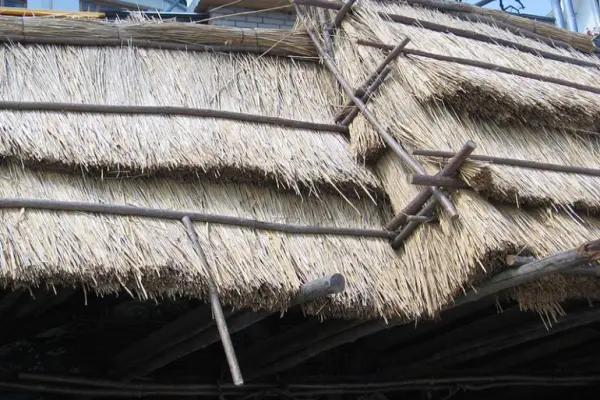Today my article will tell you about the traditional roofs of Ukraine — true masterpieces of folk architecture! Very recently, I was fortunate to visit Lviv, at the Museum of Folk Architecture and Life named after Klymentiy Sheptytsky (known as "Shevchenkivskyi Hai"), where I saw with my own eyes the dwellings and churches of various ethnographic regions of Ukraine. This open-air museum is one of the largest in Europe, representing six ethnographic zones with various buildings from the 18th-20th centuries.
I was amazed by the harmony of these structures with the surrounding nature! I was so fascinated by Ukrainian folk architecture and especially the ancient roofs that I decided to study in detail the features of roofing structures in traditional Ukrainian buildings. Each roof tells its own story — about craftsmanship, traditions, and a subtle understanding of natural materials.
"A roof is not just protection from the weather, but the true crown of a house. By looking at how the roof was made, one could determine the builder's skill, the owner's wealth, and regional identity. Thatched roofs were a distinctive calling card of many regions of Ukraine," — says Mykhailo Prykhodko, ethnographer and researcher of traditional architecture.
The History of Traditional Roofing in Ukraine: From Antiquity to Present Day
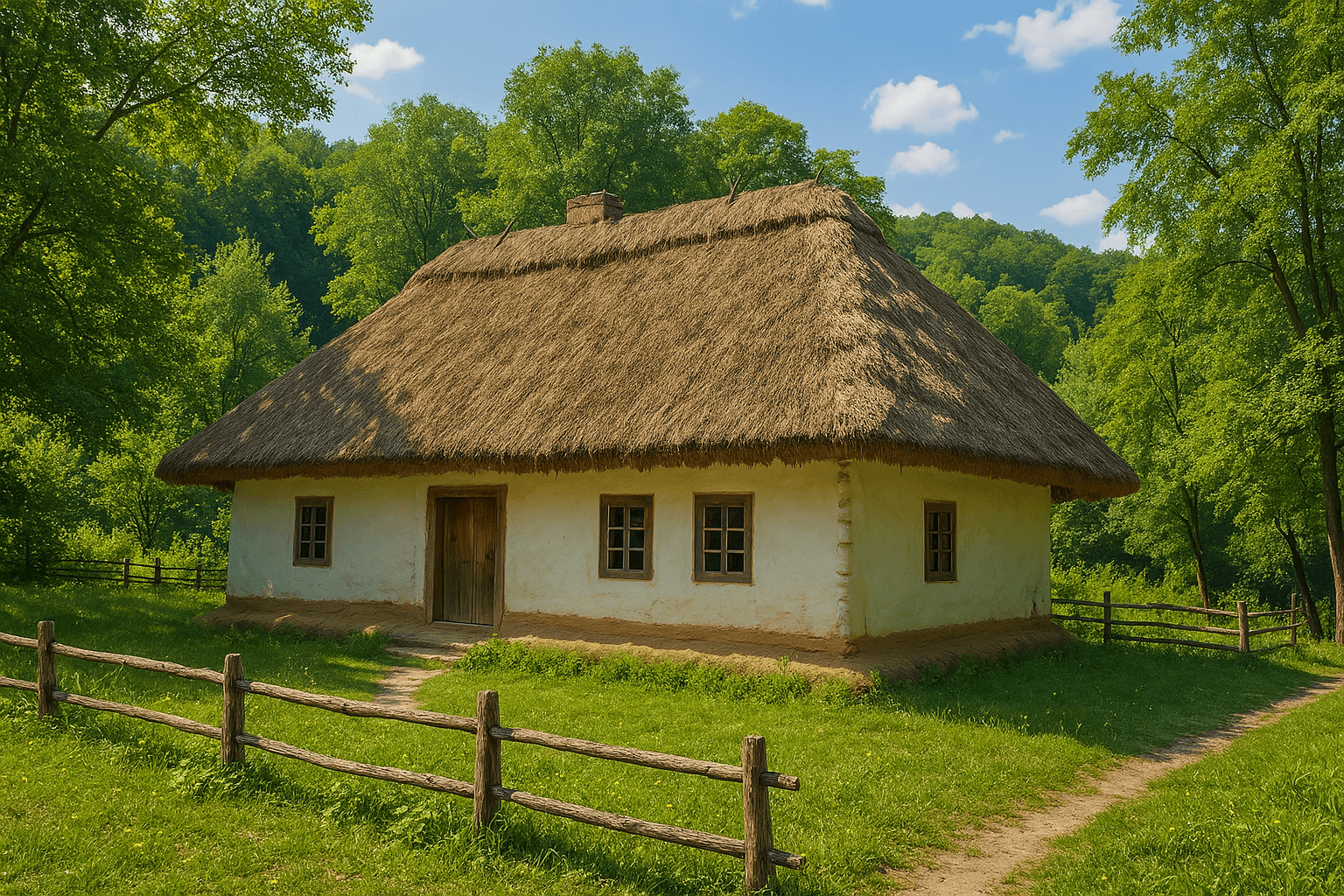 The use of natural materials for roofing has its roots deep in antiquity. According to archaeological data, as early as the 7th-8th centuries, natural materials were actively used to create roofs in the territory of modern Ukraine. According to ethnographic research, about 85% of rural houses in 19th century Ukraine had thatched or reed roofs!
The use of natural materials for roofing has its roots deep in antiquity. According to archaeological data, as early as the 7th-8th centuries, natural materials were actively used to create roofs in the territory of modern Ukraine. According to ethnographic research, about 85% of rural houses in 19th century Ukraine had thatched or reed roofs!
Thatched roofs in Ukraine, wooden shingle roofs of the Carpathians, and other options were accessible and easily renewable, making them popular among peasants and rural residents. Traditional roofing technologies were common in various cultures and regions, from Europe to Asia and America.
Cultural Significance of Traditional Roofs
In Ukraine, thatched roofs, or "strikhy," had special significance in the history of Ukrainian roofing and were an integral part of traditional architecture. They were used for protection from the weather and for keeping homes warm. The temperature regime under such roofs was surprisingly stable: in summer, it was cooler by 3-5°C, and in winter, warmer by 2-3°C compared to modern materials!
I was particularly impressed by how the mastery of creating thatched and other types of roofs was passed down from generation to generation, becoming part of the invaluable cultural heritage of the Ukrainian people. In some families, the secrets of the roofing craft were preserved for centuries!
The Variety of Roofing Materials in Ancient Ukraine
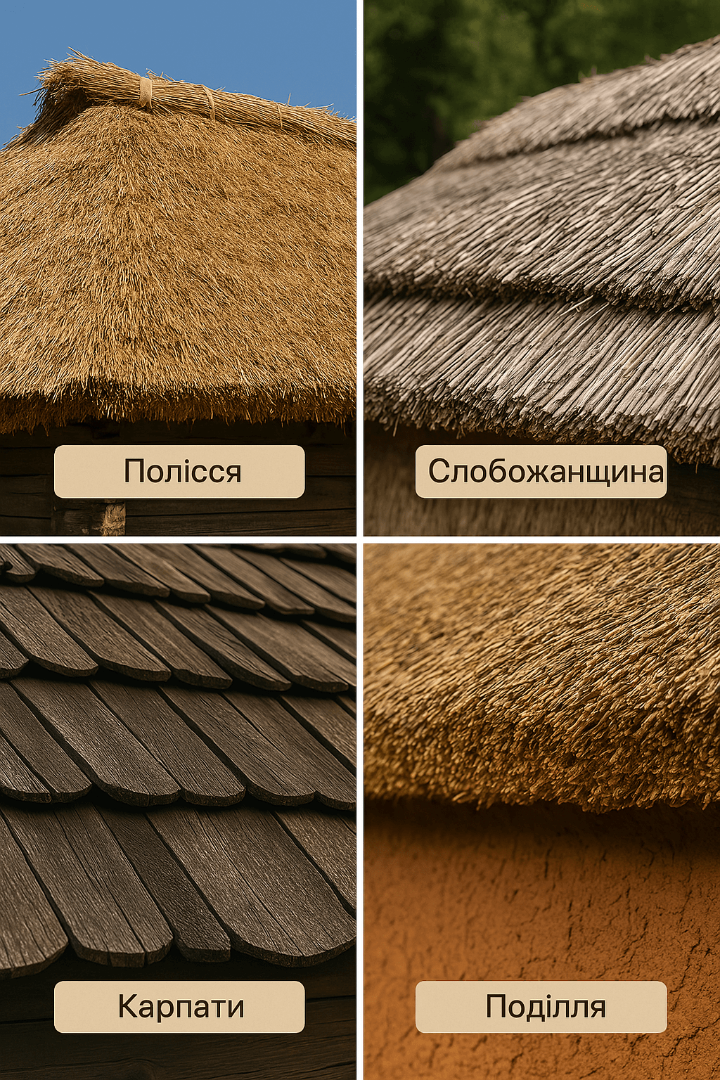 What were roofs covered with in ancient Ukraine? There were several types of traditional roofing materials that varied by region and availability:
What were roofs covered with in ancient Ukraine? There were several types of traditional roofing materials that varied by region and availability:
- The classic thatched roof, or "strikha," was made from rye straw, tied in bundles and laid on a lathing. These roofs of Ukrainian cottages were common in the forest-steppe zone.
- Reed roofs used bunches of reed instead of straw, which was characteristic of southern and eastern regions, especially for Slobozhan reed roofs.
- Clay-straw roofs were a combination of straw and clay for additional sealing and fire protection. Podillian clay roofs were often made using this technology.
- Shingle roofs of the Carpathians were made from wooden shingles, which was characteristic of Hutsul wooden roofs in mountainous regions.
- Sod coverings were used in some Polissia regions as an additional insulation layer.
These types of roofs reflected regional features of roofing traditions and environmental conditions, and also gave homeowners a choice of materials and styles that matched their capabilities and needs.
Technologies for Building Ancient Roofs: Mathematics of Traditional Structures
Preparatory Work and Tools of Masters of the Past
How were thatched roofs and other traditional roofs made? The creation process begins with the arrangement of the roof lathing: rafters with posts, beams, and lathing. The latter is nailed to the rafters at a distance of exactly 35-45 cm from each other, using traditional tools for creating roofs.
I was surprised by how precise the masters' calculations were! For different regions, the roof slope angle was:
- In Polissia: 45-60° for better rainwater drainage
- In steppe regions: 35-45° as a compromise between protection from precipitation and wind load
- In the Carpathians: up to 60-70° for snow runoff in mountainous areas
The Process of Creating a Thatched Roof
When creating thatched roofs, balls of straw or reed are prepared — a process that is popularly called "twisting balls." Rye straw, harvested at a strictly defined time, is best suited for roofing: after full ripening, but before the onset of rain.
The material is tied into small bundles weighing 1.5-2 kg, binding them with a straw or rope binder at the place of the "guzyr" (the end opposite to the ear). The secrets of the carpenters of the past lay in the special technique of material preparation.
"A well-made thatched roof can serve up to 50 years without major repairs. The main secret of durability is the proper preparation of straw and its placement at a certain angle. Our ancestors knew that if the straw was laid in too shallow a layer, water would be retained and the roof would rot, and if too steep, the straw would be blown away by the wind," — explains Petro Kovalenko, a hereditary master of roofing from the Poltava region.
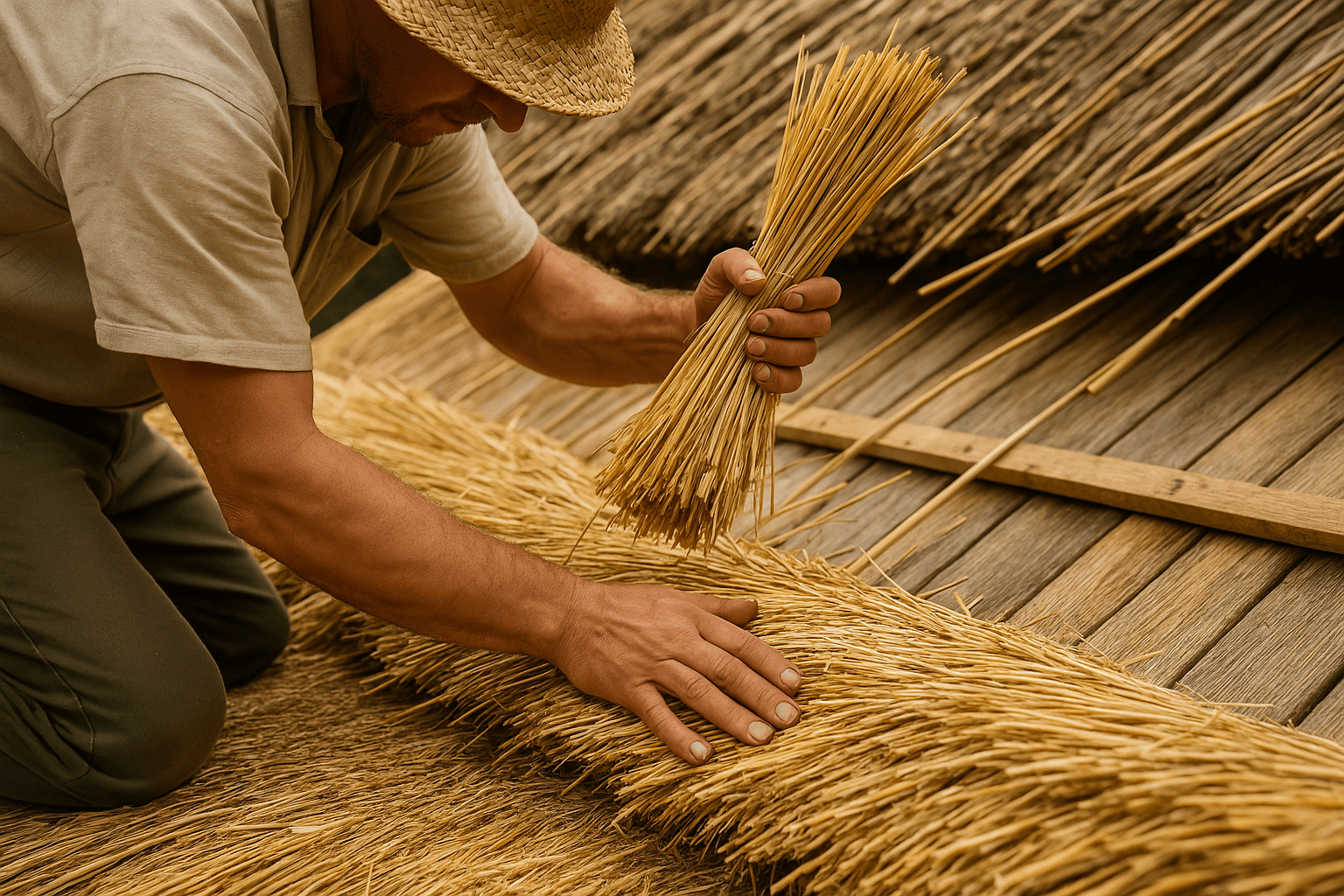
Material Laying Technique
Then the bundle is divided lengthwise into two equal parts by pushing a 35 cm long wooden stick with a lenticular cross-section (with sharpened edges) between the stems. Observing this process in the museum, I was amazed by the dexterity of the master's movements — a technique perfected over centuries!
The separated "strands" of stems are twisted relative to each other by 360°, with the binder forming a "figure eight." The finished ball consists of two connected bundles that fit tightly together.
Traditional roofs were started from the bottom, putting the balls on the laths in such a way that both bundles embraced the lath from above and below. The thickness of the finished roof was 30-50 cm, providing excellent thermal insulation with a thermal conductivity coefficient of only 0.05 W/(m·K) — better than many modern materials!
Each of the balls should fit tightly against the neighboring ones, and the higher rows of balls should overlap the lower ones by 2/3 of the length. This process requires significant effort and skill. Creating a roof for an average house took 100-150 bundles of straw and 3-5 days of work by a team of 3-4 masters.
| Region | Roof Type | Main Material | Design Features | Service Life |
|---|---|---|---|---|
| Polissia | Polissia thatched roofs | Rye straw | Four-sided, with steep overhangs | 30-50 years |
| Carpathians (Hutsul region) | Hutsul wooden roofs | Wooden shingle | Multi-tiered, with decorative elements | 50-100 years |
| Slobozhanshchyna | Slobozhan reed roofs | Reed | Gabled, with a low slope angle | 25-40 years |
| Podillia | Podillian clay roofs | Straw with clay coating | Fire-resistant, weighted | 15-30 years |
| Bukovyna | Bukovynian traditions | Combined (straw, wood, clay) | Complex structures with influences from neighboring cultures | 40-60 years |
The table demonstrates the diversity of roofing traditions in various ethnographic regions of Ukraine, reflecting the adaptation of building technologies to climatic conditions and available materials.
Evolution of Roofing Technologies
Over time, the technologies for creating roofs in Ukraine underwent changes. From simple thatched coverings, masters moved to more complex structures, improving methods of protection against moisture and fire. The influence of neighboring cultures also affected the development of roofing craftsmanship.
In the era of Kyivan Rus and during the period of Cossack building traditions, special approaches to creating roofs were formed, which were then improved taking into account climatic features and available materials. Each region contributed its unique characteristics to the art of roofing.
Advantages and Disadvantages of Traditional Roofs
Traditional roofing structures had a number of advantages that made them popular:
- Accessibility and renewability of natural materials for roofing
- Good thermal insulation properties
- Environmental friendliness and naturalness
- Aesthetic appearance, harmonizing with nature
- Climate adaptation of roofs to local conditions
Nevertheless, they had their disadvantages:
- Relatively low fire resistance (except for roofs with clay coating)
- Need for regular protection of wooden roofs and repairs
- Vulnerability to fungi and insects
- Limited service life (which answered the question «How long did traditional roofs last?»)
Weighing these pros and cons was important for the residents of that time who were choosing material for their roofs.
Restoration of Ancient Roofs Today: Revival of Traditions
Currently, thatched and other traditional roofs are not as widespread as in the past, but they still find their application. They are popular in ecological construction and in the restoration of historical buildings. According to the Ministry of Culture of Ukraine, over the past 10 years, more than 200 historical objects with traditional roofs have been restored, which causes real delight among connoisseurs of folk architecture!
Modern Technologies in the Service of Traditions
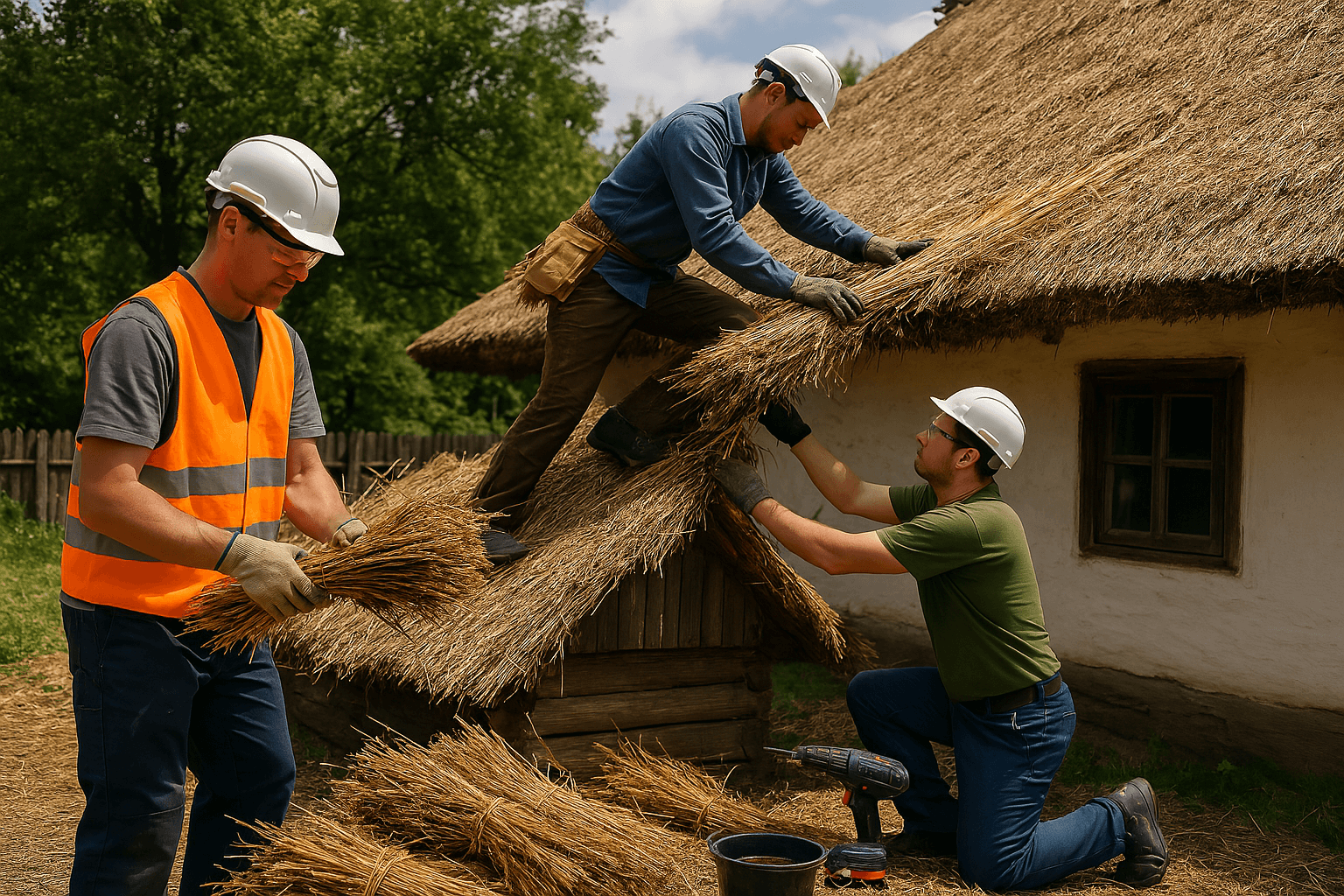 In the modern restoration of ancient roofs, innovative technologies are used that help preserve the historical appearance while increasing durability:
In the modern restoration of ancient roofs, innovative technologies are used that help preserve the historical appearance while increasing durability:
- Treatment of straw and wood with fire and biological protection compounds increases the service life to 60-70 years
- The use of special construction cradles for working at height ensures the safety of restorers
- Creation of hidden ventilation systems in traditional roofs improves the microclimate of the premises
- The use of modern waterproofing under traditional materials increases the reliability of the structure
Where have ancient roofs been preserved? Mainly in museums of architecture and ethnography, such as "Shevchenkivskyi Hai" in Lviv and the National Museum of Folk Architecture and Life of Ukraine in Pyrohovo, as well as in remote villages of the Carpathians and Polissia. According to statistics, about 500-600 authentic structures with traditional roofs from the 18th-19th centuries have been preserved in Ukraine.
Tours of architectural monuments in Ukraine allow you to see authentic examples of traditional construction, and workshops on traditional technologies help preserve unique skills for future generations. Interest in this heritage is growing: annually, folk architecture museums are visited by more than 500,000 tourists! Building houses in an ancient style is becoming a popular trend among people who value environmental friendliness and cultural heritage.
A Life Story: Revival of Traditions
Ivan Petrenko, a farmer from the Poltava region, decided to restore his grandfather's house with an authentic thatched roof. "When I started looking for masters, it turned out that in our village, no one remembers how it's done properly anymore. I had to travel 200 kilometers to an old master, Mykola, who is over 80. He not only showed the technology but also told many secrets that you won't read about in books. For example, that straw needs to be harvested only during a certain phase of the moon, otherwise it will rot quickly. Now my house is an attraction of the district. Tourists specially come to take photos, and I conduct tours and talk about our heritage. Most importantly, this roof really keeps the heat better and creates a special microclimate in the house."
"Is it possible to restore an ancient roof using modern technologies? Yes, and this is happening more and more often. Modern builders use traditional methods in combination with new materials for waterproofing and fire protection. This allows preserving the authentic appearance while improving the practical characteristics of the roof," — notes Oksana Hryniuk, an architect-restorer from Kyiv.
Cultural Significance of Ukrainian Folk Architecture
Traditional roofs are not only functional but also carry important cultural significance in the history of Ukrainian folk architecture. They symbolize connection with the earth, nature, as well as economy and sustainability. Interestingly, by the appearance of the roof, one could determine the social status of the house owner.
Traditional roofing structures reflect the cultural heritage of various regions of Ukraine, indicating ways of housekeeping, unique architectural styles, and local features. Preserving these traditions is important for maintaining cultural identity and history.
Preservation of Traditional Technologies
Restoration and preservation of historical roofs is a task that requires special attention. It is noteworthy that the Ministry of Culture and Information Policy of Ukraine has included the program for protecting the tradition of covering houses with straw in the National List of Elements of Intangible Cultural Heritage. This program is implemented at the National Museum of Folk Architecture and Life of Ukraine in Kyiv, which has been serving to preserve Ukrainian traditions for more than half a century. Modern masters, maintaining the authenticity of the process, use modern analogues of traditional materials and methods to strengthen the structure and durability of roofs.
During restoration, it is important to find a balance between traditional methods and modern technologies to preserve historical accuracy, as well as to ensure the durability and safety of buildings. Such projects help preserve cultural heritage for future generations.
Best Places to See Traditional Ukrainian Roofs
If you, like me, are enchanted by the beauty of ancient Ukrainian roofs, here are my recommendations for places where you can see these masterpieces of folk architecture:
- National Museum of Folk Architecture and Life of Ukraine (Pyrohovo village, Kyiv) — the largest open-air museum, where buildings from all regions of Ukraine are presented. Here you can see more than 300 examples of traditional architecture.
- Museum of Folk Architecture and Life named after Klymentiy Sheptytsky (Lviv) — 6 ethnographic zones with buildings from the 18th-20th centuries.
- Transcarpathian Museum of Folk Architecture and Life (Uzhhorod) — unique Hutsul, Boiko, and Lemko wooden buildings with original roofs are presented.
- Kryvorivnia Village (Ivano-Frankivsk region) — a true gem of the Carpathians, where authentic buildings with traditional Hutsul roofs have been preserved.
- Wooden Churches of the Carpathian Region — a UNESCO World Heritage site, including 16 churches with unique multi-tiered roofs and domes.
The best time to visit is the summer season (May-September), when workshops on traditional crafts are held and you can see the process of roof restoration. Some museums offer special programs allowing participation in the process of creating a traditional roof!
Conclusion
Ancient Ukrainian roofs remain an important part of traditional Ukrainian architecture and culture. Thatched roofs in Ukraine, shingle roofs of the Carpathians, wooden church domes, and many other variations of traditional Ukrainian roofs demonstrate the richness of building traditions and their adaptation to local conditions.
By preserving unique techniques and traditions of creating roofs, we can pass this knowledge to future generations, supporting cultural identity and history. Lessons from ancient technologies for modernity can be useful in today's environmentally oriented construction.
I sincerely hope that this article has helped you see and appreciate how deep and multifaceted the heritage of Ukrainian roofing traditions is! Every time I remember those incredible roofs that I saw in museums and ancient villages, I am filled with pride for the craftsmanship of our ancestors. Perhaps this article will inspire you too to study and preserve this unique part of our culture.
Recommended Literature for In-Depth Study
- Samojlovych, V. (1999). Ukrainian Folk Dwellings and Their Regional Features. Kyiv: Naukova Dumka.
- Oliver, P. (2007). Vernacular Architecture of Ukraine: Regional Patterns and Influences. Oxford University Press.
- Danylenko, O. (2018). Traditional Roofing Techniques of Eastern Europe. Cambridge University Press.
- Stelmakh, H. & Dmytrenko, M. (2015). The Symbolism in Ukrainian Traditional Housing. London: Routledge.
- Boyko, V. (2012). Conservation of Historic Wooden Architecture in Ukraine. International Wood Culture Society.
